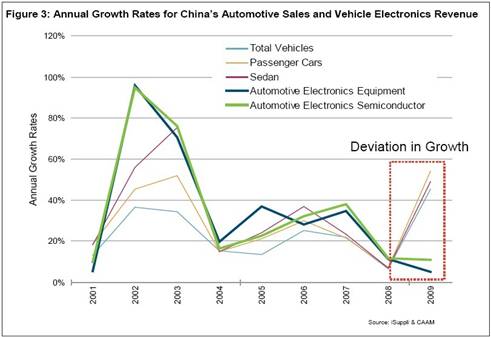Stimulus policy drives the prosperity of China's auto market
According to iSuppli, spurred by the Chinese government's subsidy policy, China's cross-border car sales increased sharply in 2009, driving China's auto production that year by 48%.
In 2009, China's overall automobile production rose to 13.8 million units, a 48% increase from 2008. At the same time, domestic car sales rose to 13.6 million in 2009, an increase of 46% over 2008. In contrast, in 2008 automobile production increased by 5.6% and sales increased by 6.7%.
At the end of 2008, China launched a series of economic stimulus measures to promote production and consumption. A stimulus policy for the automotive industry is to reduce the purchase tax on passenger cars with a displacement of 1.6 liters or less by 50%.
This policy is extremely effective in stimulating the purchase of ordinary passenger cars, and these models have contributed greatly to the overall growth of the automotive market in 2009. The reduction in vehicle purchase tax and subsidies provided by the Automobile Going to the Country program stimulated cross-border car sales in the first 11 months of 2009 to increase by 80.7% compared with the same period in 2008.
Although auto sales have increased significantly, China's auto electronics industry may not necessarily benefit.
iSuppli estimates that China's automotive electronics business revenue in 2009 totaled 14.1 billion US dollars, an increase of only 4.9% over 2008. In contrast, China's automotive electronics market grew by 11.2% in 2008.
Figure 3 shows the annual growth rate of China's automobile sales and operating income of automotive electronics and semiconductors. It can be clearly seen that the growth of the two is not consistent.

The main reason is that the stimulus policy is mainly driven by low-end car sales, and the electronic content in such cars is relatively small.
The proportion of electronic components in passenger cars in Europe and America is 18-20%. In China, the ratio of domestic auto manufacturers is relatively low, at 10-12%. However, all Chinese car manufacturers plan to increase the use of electronic devices.
After a decline of 2.8% in 2008, China's automotive infotainment electronics market is estimated to have dropped by 6.1% in 2009. The market is mainly composed of entertainment applications. As there is no indication that global auto consumption will rebound strongly in the next three years, the shipment of entertainment products made in China will maintain a downward trend.
As in previous years, the powertrain sector has maintained steady growth, almost at the same growth rate as car sales, especially the popular small-displacement passenger car powertrain system. In addition, compared with other poorly performing applications, the 23% annual growth rate in the powertrain field makes it the fastest growing automotive electronics market. Operating income has maintained steady growth, and powertrain products produced in China will go further in the next three years.
iSuppli predicts that semiconductor consumption in China's automotive infotainment market will reach US $ 2 billion in 2009, an increase of 11% over 2008.
Isaac Wang is a senior analyst at iSuppli's China Research Department.
SHAOXING COLORBEE PLASTIC CO.,LTD , http://www.fantaicolorbee.com
